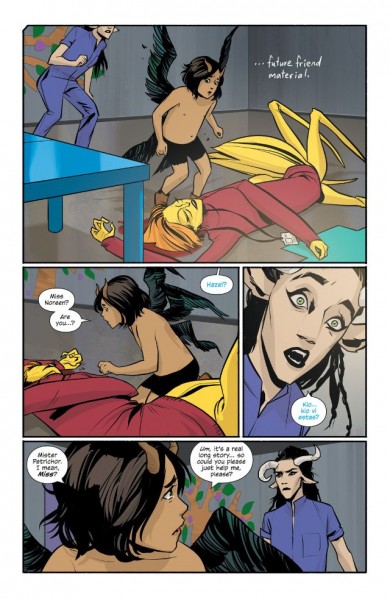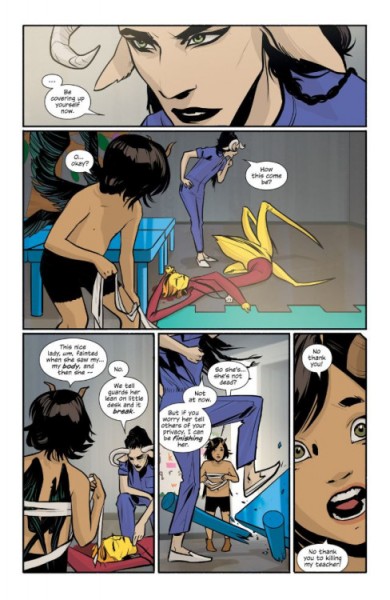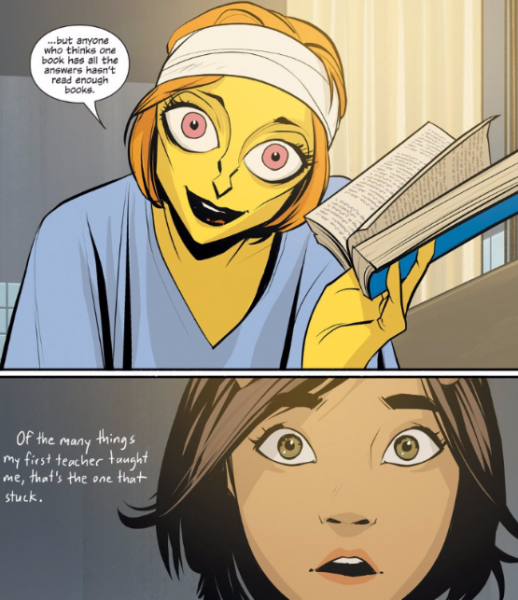Saga #34 Review
"New Allies"
After an issue that entirely followed tabloid journalists Upsher and Doff,
Saga #34 comes back with an “everybody” issue, in which the story checks in on three important, separate stories. It’s a nice reminder of what works well about the series, and though it’s not the best issue of the recent arc, it does a lot of valuable story work, moving the narrative along in significant ways that figure to pan out in future issues. As always, Brian K. Vaughan and Fiona Staples also have some intelligent social commentary.

Two issues ago, Hazel revealed her wings to her teacher Noreen, causing the woman to faint and smash her head. In
Saga #34, Hazel is helped by a transgender prisoner named Petrichor, who gets Noreen medical help and also covers up Hazel, knowing that her secret is dangerous. When recovered, Noreen not only agrees to keep Hazel’s secret but to help her escape. Meanwhile, Alana and Marko meet up with Prince Robot IV (who is no longer a prince) in exile with his growing son and the seal-like Ghus. Alana and Marko need the Robot’s help and although he is not feeling like assisting, his son shows him that they should. Finally, The Will, who is traveling with a captured Upsher and Doff, gets them to reveal some useful information about where The Will can find Alana and Marko.
This is obviously a jammed summary and shows how much story is occurring in
Saga #34. The cliffhanger of issue #32, in which Hazel reveals her nature to Noreen has a pay-off, though it’s not the one that many readers may have expected. For the most part, Alana and Marko’s affair has been treated with scorn and Hazel’s dual-nature is often characterized by others as “freakish.” So Noreen’s apparent open-mindedness is surprising but also pushes the story into an exciting new direction, with Hazel’s possibly attempting to escape being a dangerous proposition. Similarly, the Alana/Marko and The Will stories are finessed so that they are all on a collision course once again.

Of course, while
Saga is usually a very engaging and well-crafted story, viewing it as “just” a story misses some of the richness of the series. There are some interesting themes employed by Vaughan and Staples here. Both Hazel and Petrichor have a biological issues that are treated with scorn by others, and it’s resonant that it is Petrichor who ends up helping Hazel. She is more than simply social-issue character, too, because she has some real character. Similarly, Noreen so far seems like a non-prejudiced being, so when she tells Hazel while referring to an Oswalt Heist novel that “Anyone who thinks that one book has all the answers hasn’t read enough books,” it’s a loaded line. Though it has no connection to religion in the story, it’s hard to not read it as a commentary of religion since zealots are really the only people who believe that one book contains all the answers. This moment is handled well by Vaughan and Staples – it makes a point without being preachy.
With
Saga #34 occurring years after the series was begun, the issue presents an noteworthy example of something that Fiona Staples does in her art for
Saga that many long-term comic books do not do – have characters change physically. Comics are fine with internal changes but for the most part characters look mostly the same. In
Saga #34, we meet the young son of Prince Robot IV, a character who has himself changed. In recent issues – after a forward time jump in the narrative – we have seen physical changes to Alana, Hazel, The Will and others. They are subtle changes from Staples since this is only a few years, but it’s enough to remind readers subconsciously that there has been a real passage of time.

There may not be any WTF shocker moment in
Saga #34, but that doesn’t make it a lesser issue. Its storytelling is still succinct and this issue actually is full of story beats that feel significant.
Saga also has a habit of throwing in shocking moments, whether sex, violence or cultural, and those moments occasionally overwhelm the story. However,
Saga #34 handles its social commentary with a large degree of subtlety, clearly making its points without superseding the overall story.
Pros
- Three different story threads that are propelled efficiently
- The commentary on social issues is subtle and serves the story
- Staples using small physical changes to show passage of time
Cons
- The issue is more about set-up than pay-off
 Two issues ago, Hazel revealed her wings to her teacher Noreen, causing the woman to faint and smash her head. In Saga #34, Hazel is helped by a transgender prisoner named Petrichor, who gets Noreen medical help and also covers up Hazel, knowing that her secret is dangerous. When recovered, Noreen not only agrees to keep Hazel’s secret but to help her escape. Meanwhile, Alana and Marko meet up with Prince Robot IV (who is no longer a prince) in exile with his growing son and the seal-like Ghus. Alana and Marko need the Robot’s help and although he is not feeling like assisting, his son shows him that they should. Finally, The Will, who is traveling with a captured Upsher and Doff, gets them to reveal some useful information about where The Will can find Alana and Marko.
This is obviously a jammed summary and shows how much story is occurring in Saga #34. The cliffhanger of issue #32, in which Hazel reveals her nature to Noreen has a pay-off, though it’s not the one that many readers may have expected. For the most part, Alana and Marko’s affair has been treated with scorn and Hazel’s dual-nature is often characterized by others as “freakish.” So Noreen’s apparent open-mindedness is surprising but also pushes the story into an exciting new direction, with Hazel’s possibly attempting to escape being a dangerous proposition. Similarly, the Alana/Marko and The Will stories are finessed so that they are all on a collision course once again.
Two issues ago, Hazel revealed her wings to her teacher Noreen, causing the woman to faint and smash her head. In Saga #34, Hazel is helped by a transgender prisoner named Petrichor, who gets Noreen medical help and also covers up Hazel, knowing that her secret is dangerous. When recovered, Noreen not only agrees to keep Hazel’s secret but to help her escape. Meanwhile, Alana and Marko meet up with Prince Robot IV (who is no longer a prince) in exile with his growing son and the seal-like Ghus. Alana and Marko need the Robot’s help and although he is not feeling like assisting, his son shows him that they should. Finally, The Will, who is traveling with a captured Upsher and Doff, gets them to reveal some useful information about where The Will can find Alana and Marko.
This is obviously a jammed summary and shows how much story is occurring in Saga #34. The cliffhanger of issue #32, in which Hazel reveals her nature to Noreen has a pay-off, though it’s not the one that many readers may have expected. For the most part, Alana and Marko’s affair has been treated with scorn and Hazel’s dual-nature is often characterized by others as “freakish.” So Noreen’s apparent open-mindedness is surprising but also pushes the story into an exciting new direction, with Hazel’s possibly attempting to escape being a dangerous proposition. Similarly, the Alana/Marko and The Will stories are finessed so that they are all on a collision course once again.
 Of course, while Saga is usually a very engaging and well-crafted story, viewing it as “just” a story misses some of the richness of the series. There are some interesting themes employed by Vaughan and Staples here. Both Hazel and Petrichor have a biological issues that are treated with scorn by others, and it’s resonant that it is Petrichor who ends up helping Hazel. She is more than simply social-issue character, too, because she has some real character. Similarly, Noreen so far seems like a non-prejudiced being, so when she tells Hazel while referring to an Oswalt Heist novel that “Anyone who thinks that one book has all the answers hasn’t read enough books,” it’s a loaded line. Though it has no connection to religion in the story, it’s hard to not read it as a commentary of religion since zealots are really the only people who believe that one book contains all the answers. This moment is handled well by Vaughan and Staples – it makes a point without being preachy.
With Saga #34 occurring years after the series was begun, the issue presents an noteworthy example of something that Fiona Staples does in her art for Saga that many long-term comic books do not do – have characters change physically. Comics are fine with internal changes but for the most part characters look mostly the same. In Saga #34, we meet the young son of Prince Robot IV, a character who has himself changed. In recent issues – after a forward time jump in the narrative – we have seen physical changes to Alana, Hazel, The Will and others. They are subtle changes from Staples since this is only a few years, but it’s enough to remind readers subconsciously that there has been a real passage of time.
Of course, while Saga is usually a very engaging and well-crafted story, viewing it as “just” a story misses some of the richness of the series. There are some interesting themes employed by Vaughan and Staples here. Both Hazel and Petrichor have a biological issues that are treated with scorn by others, and it’s resonant that it is Petrichor who ends up helping Hazel. She is more than simply social-issue character, too, because she has some real character. Similarly, Noreen so far seems like a non-prejudiced being, so when she tells Hazel while referring to an Oswalt Heist novel that “Anyone who thinks that one book has all the answers hasn’t read enough books,” it’s a loaded line. Though it has no connection to religion in the story, it’s hard to not read it as a commentary of religion since zealots are really the only people who believe that one book contains all the answers. This moment is handled well by Vaughan and Staples – it makes a point without being preachy.
With Saga #34 occurring years after the series was begun, the issue presents an noteworthy example of something that Fiona Staples does in her art for Saga that many long-term comic books do not do – have characters change physically. Comics are fine with internal changes but for the most part characters look mostly the same. In Saga #34, we meet the young son of Prince Robot IV, a character who has himself changed. In recent issues – after a forward time jump in the narrative – we have seen physical changes to Alana, Hazel, The Will and others. They are subtle changes from Staples since this is only a few years, but it’s enough to remind readers subconsciously that there has been a real passage of time.
 There may not be any WTF shocker moment in Saga #34, but that doesn’t make it a lesser issue. Its storytelling is still succinct and this issue actually is full of story beats that feel significant. Saga also has a habit of throwing in shocking moments, whether sex, violence or cultural, and those moments occasionally overwhelm the story. However, Saga #34 handles its social commentary with a large degree of subtlety, clearly making its points without superseding the overall story.
There may not be any WTF shocker moment in Saga #34, but that doesn’t make it a lesser issue. Its storytelling is still succinct and this issue actually is full of story beats that feel significant. Saga also has a habit of throwing in shocking moments, whether sex, violence or cultural, and those moments occasionally overwhelm the story. However, Saga #34 handles its social commentary with a large degree of subtlety, clearly making its points without superseding the overall story.